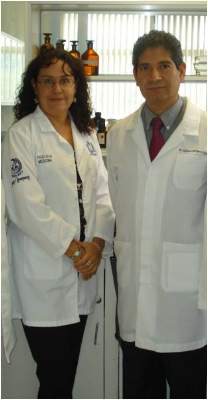User login
The same dysregulated proteins that form in the brains of patients with Alzheimer’s disease or Parkinson’s disease appear to clump within their skin cells as well, according to new research released Feb. 24 in advance of the annual meeting of the American Academy of Neurology.
In a small prospective study, epidermal samples from patients showed intracellular aggregates of phosphorylated tau, a pathologic hallmark of both Alzheimer’s and Parkinson’s. Patients with Parkinson’s disease also showed a similarly increased expression of alpha-synuclein. But neither protein was present in any of the samples taken from healthy control subjects.
If these findings can be validated in large groups, epidermal protein aggregation might have some potential as a biomarker for both Alzheimer’s and Parkinson’s diseases and perhaps in other proteinopathies, such as frontotemporal dementia, progressive supranuclear palsy, and corticobasal syndrome, according to Dr. Ildefonso Rodríguez-Leyva of the University of San Luis Potosí (Mexico). He and his colleague, Dr. María E. Jiménez-Capdeville, will present their findings at the meeting in April.
Their current work builds on initial data presented at the 2012 annual meeting, and later published (Ann. Clin. Transl. Neurol. 2014;1:471-8). That study showed that about 60% of cells in specific skin structures in patients with Parkinson’s disease had alpha-synuclein inclusions.
The current study included 65 subjects: 20 with Alzheimer’s, 16 with Parkinson’s, 17 with non-neurodegenerative dementia, and 12 age-matched healthy controls. All patients were in the mild-moderate stage of their illnesses. Each underwent a retroauricular punch biopsy. This is an ideal area because the procedure leaves no visible scar and bleeding is easy to control, Dr. Rodríguez-Leyva said in an interview. Samples were analyzed by immunohistochemistry.
Finding these proteins in the skin of patients with neurodegenerative diseases makes sense, Dr. Rodríguez-Leyva said, because neurons and epidermal cells arise from the same fetal lamina – the ectoderm. “Because these cells have the same origin, our thought is that they should have a similar program of protein expression. Therefore, the skin may reflect adverse events taking place in the nervous system.”This initial study didn’t attempt to correlate epidermal protein expression and disease stage. But that study is coming, Dr. Rodríguez-Leyva said. “We can’t be sure at this point if there is any relationship there. We need to test more patients in different points of disease progression to know if the levels of altered proteins correlate with disease evolution.”
Neither Dr. Rodríguez-Leyva nor Dr. Jiménez-Capdeville had any financial disclosures. The study was supported by the National Council of Science and Technology of Mexico.
On Twitter @alz_gal
The same dysregulated proteins that form in the brains of patients with Alzheimer’s disease or Parkinson’s disease appear to clump within their skin cells as well, according to new research released Feb. 24 in advance of the annual meeting of the American Academy of Neurology.
In a small prospective study, epidermal samples from patients showed intracellular aggregates of phosphorylated tau, a pathologic hallmark of both Alzheimer’s and Parkinson’s. Patients with Parkinson’s disease also showed a similarly increased expression of alpha-synuclein. But neither protein was present in any of the samples taken from healthy control subjects.
If these findings can be validated in large groups, epidermal protein aggregation might have some potential as a biomarker for both Alzheimer’s and Parkinson’s diseases and perhaps in other proteinopathies, such as frontotemporal dementia, progressive supranuclear palsy, and corticobasal syndrome, according to Dr. Ildefonso Rodríguez-Leyva of the University of San Luis Potosí (Mexico). He and his colleague, Dr. María E. Jiménez-Capdeville, will present their findings at the meeting in April.
Their current work builds on initial data presented at the 2012 annual meeting, and later published (Ann. Clin. Transl. Neurol. 2014;1:471-8). That study showed that about 60% of cells in specific skin structures in patients with Parkinson’s disease had alpha-synuclein inclusions.
The current study included 65 subjects: 20 with Alzheimer’s, 16 with Parkinson’s, 17 with non-neurodegenerative dementia, and 12 age-matched healthy controls. All patients were in the mild-moderate stage of their illnesses. Each underwent a retroauricular punch biopsy. This is an ideal area because the procedure leaves no visible scar and bleeding is easy to control, Dr. Rodríguez-Leyva said in an interview. Samples were analyzed by immunohistochemistry.
Finding these proteins in the skin of patients with neurodegenerative diseases makes sense, Dr. Rodríguez-Leyva said, because neurons and epidermal cells arise from the same fetal lamina – the ectoderm. “Because these cells have the same origin, our thought is that they should have a similar program of protein expression. Therefore, the skin may reflect adverse events taking place in the nervous system.”This initial study didn’t attempt to correlate epidermal protein expression and disease stage. But that study is coming, Dr. Rodríguez-Leyva said. “We can’t be sure at this point if there is any relationship there. We need to test more patients in different points of disease progression to know if the levels of altered proteins correlate with disease evolution.”
Neither Dr. Rodríguez-Leyva nor Dr. Jiménez-Capdeville had any financial disclosures. The study was supported by the National Council of Science and Technology of Mexico.
On Twitter @alz_gal
The same dysregulated proteins that form in the brains of patients with Alzheimer’s disease or Parkinson’s disease appear to clump within their skin cells as well, according to new research released Feb. 24 in advance of the annual meeting of the American Academy of Neurology.
In a small prospective study, epidermal samples from patients showed intracellular aggregates of phosphorylated tau, a pathologic hallmark of both Alzheimer’s and Parkinson’s. Patients with Parkinson’s disease also showed a similarly increased expression of alpha-synuclein. But neither protein was present in any of the samples taken from healthy control subjects.
If these findings can be validated in large groups, epidermal protein aggregation might have some potential as a biomarker for both Alzheimer’s and Parkinson’s diseases and perhaps in other proteinopathies, such as frontotemporal dementia, progressive supranuclear palsy, and corticobasal syndrome, according to Dr. Ildefonso Rodríguez-Leyva of the University of San Luis Potosí (Mexico). He and his colleague, Dr. María E. Jiménez-Capdeville, will present their findings at the meeting in April.
Their current work builds on initial data presented at the 2012 annual meeting, and later published (Ann. Clin. Transl. Neurol. 2014;1:471-8). That study showed that about 60% of cells in specific skin structures in patients with Parkinson’s disease had alpha-synuclein inclusions.
The current study included 65 subjects: 20 with Alzheimer’s, 16 with Parkinson’s, 17 with non-neurodegenerative dementia, and 12 age-matched healthy controls. All patients were in the mild-moderate stage of their illnesses. Each underwent a retroauricular punch biopsy. This is an ideal area because the procedure leaves no visible scar and bleeding is easy to control, Dr. Rodríguez-Leyva said in an interview. Samples were analyzed by immunohistochemistry.
Finding these proteins in the skin of patients with neurodegenerative diseases makes sense, Dr. Rodríguez-Leyva said, because neurons and epidermal cells arise from the same fetal lamina – the ectoderm. “Because these cells have the same origin, our thought is that they should have a similar program of protein expression. Therefore, the skin may reflect adverse events taking place in the nervous system.”This initial study didn’t attempt to correlate epidermal protein expression and disease stage. But that study is coming, Dr. Rodríguez-Leyva said. “We can’t be sure at this point if there is any relationship there. We need to test more patients in different points of disease progression to know if the levels of altered proteins correlate with disease evolution.”
Neither Dr. Rodríguez-Leyva nor Dr. Jiménez-Capdeville had any financial disclosures. The study was supported by the National Council of Science and Technology of Mexico.
On Twitter @alz_gal
FROM THE AAN 2015 ANNUAL MEETING
Key clinical point: The abnormal brain proteins of Alzheimer’s and Parkinson’s may also be expressed in skin cells.
Major finding: Tau and alpha-synuclein were expressed in the epidermal cells of patients, but not in those of healthy controls.
Data source: The prospective study comprising 65 subjects (20 with Alzheimer’s, 16 with Parkinson’s, 17 with non-neurodegenerative dementia, and 12 age-matched healthy controls).
Disclosures: Neither Dr. Rodríguez-Leyva nor Dr. Jiménez-Capdeville had any financial disclosures. The study was supported by the National Council of Science and Technology of Mexico.

